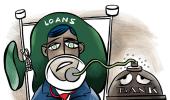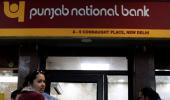'The PSBs ended up recording Rs 7,709 crore losses in the March quarter compared to the Rs 11,688 crore profits of their private peers,' reveals Tamal Bandyopadhyay.

Three perennially loss-making banks have returned to the profit track.
IDBI Bank Ltd, which carries the soul of a public sector bank in a private bank's body, recorded a net profit of Rs 139 crore in the March quarter of FY20.
Indian Overseas Bank's net profit is even higher -- Rs 144 crore.
Kolkata-headquartered Uco Bank too came back to the black, albeit with a smaller profit of Rs 17 crore.
Why does this call for celebrations?
For IOB, it's profit after 18 quarters. It had been making losses since September 2015 when the Reserve Bank of India decided to take a close look at the banks' bad loans through an intense inspection called asset quality review.
Since then, till December 2019, the Chennai-based bank's accumulated losses had been Rs 25,037 crore.
Uco Bank had got into the red zone a quarter later, in December 2015. Till December 2019, in 17 quarters, its accumulated losses had been Rs 16,274 crore.
IDBI Bank's return to profit has been relatively quicker -- after 13 successive quarters but its quantum of losses has been more than that of the two banks put together, Rs 41,832 crore.
Like Uco Bank, IDBI Bank, too, started its losing streak in December 2015, but unlike the other two, it had made small profits in the June and September quarters of 2016.
The return to profit of these three could have made March 2020 a landmark quarter, but some of the larger banks have spoilt the party.
Bank of India tops the list with a Rs 3,571 crore loss, followed by Canara Bank (Rs 3,259 crore), Union Bank of India (Rs 2,503 crore), Central Bank of India (Rs 1,529 crore), Punjab National Bank (Rs 697 crore), Punjab & Sind Bank (Rs 236 crore) and Indian Bank (Rs 218 crore).
Overall, of the 12 public sector banks, seven had posted losses in the March quarter.
As a pack, the PSBs ended up recording Rs 7,709 crore losses in the March quarter compared to the Rs 11,688 crore profits of their private peers. The number of PSBs has shrunk following consolidation and I am not clubbing IDBI Bank with them.
There is a silver lining, though: All PSBs have made operating profits. Collectively, that is Rs 38,013 crore -- not very far behind the private banks' overall operating profit of Rs 46,304 crore. But their entire operating profit has been eaten away by provisions for bad loans.
The group of PSBs has set aside Rs 50,318 crore for bad loans in the March quarter, about 50 per cent higher than the private banks (Rs 32,687 crore).
This brings us to the most critical aspect of a bank's balance sheet -- the non-performing assets or NPAs. The gross NPAs of all PSBs have been coming down.
Still eight of the 12 have gross NPAs in double digits.
As a percentage of the loan book, Central Bank has the highest gross NPAs of 18.92 per cent, followed by Uco Bank (16.77 per cent).
Another five PSBs have more than 14 per cent but less than 15 per cent gross NPAs. None can, however, dislodge IDBI Bank from its numero uno position. It has 27.53 per cent gross NPAs.
The new entrant in the high bad-loan club in the private sector is Yes Bank Ltd (16.80 per cent). It had been in bad health for the past few years, thanks to all sorts of dubious exposures, but kept on fooling the regulator through many innovations.
Among the government-owned banks, State Bank of India has the lowest gross NPAs -- 6.15 per cent; in the pack of private banks, HDFC Bank Ltd (1.26 per cent).
After setting aside money, the net NPAs of IDBI Bank is 4.19 per cent, the highest among private banks but lower than many PSBs.
Six of the PSBs have at least 5 per cent or more net NPAs.
Led by Punjab & Sind Bank (8.03 per cent), the list features Central Bank, Punjab National Bank, Union Bank, Uco Bank and IOB. State Bank has the lowest net NPAs in this pack -- 2.23 per cent.
The net NPAs are an indicator of a bank's health.
The gross NPAs could be high but if a bank has provided for bulk of them, the net NPAs drop. The provision makes sure that once it is able to recover the bad loans, the money recovered will add to the bank's profits.
The rise in the listed private and public sector banks' deposit as well as advance portfolios in the financial year 2020 ending March has probably been the lowest in recent history.
The growth in deposits has just been 5.64 per cent; the credit growth has been even more tepid -- 3.31 per cent.
Let's take a closer look at some of the banks' business growth. HDFC Bank's deposit growth has been 24.3 per cent; Bandhan Bank Ltd has grown its deposit portfolio at an even higher pace, 32 per cent, although on a much lower base. Yes Bank's deposit base got depleted by 54 per cent.
Among the majority government-owned banks, only State Bank has recorded a double-digit deposit growth -- 11.3 per cent, of course on a very high base. Its deposit portfolio in March was Rs 32.4 trillion while the entire pack of private banks' deposit base was Rs 38.9 trillion.
Overall, the private banks' deposit pile grew at 5.21 per cent against 5.86 per cent growth of PSBs.
This busts the myth that there is a crisis of confidence in the private sector and that customers are rushing with their money to the PSBs, seeking implicit government guarantee.
When it comes to advances, HDFC Bank's growth has been 21 per cent and that of Bandhan Bank 60 per cent. A few private banks have shown a drop in their advance portfolio.
Yes Bank's loan book has shrunk by 29 per cent. Barring IOB and Uco Bank, all PSBs have shown growth in their loan books -- in single digits.
Indian Bank tops the chart with a 9.6 per cent growth.
Most banks have provided for a large part of their bad loans. With recovery gathering momentum, their health would improve. Or, so we had thought in March. But the pandemic has queered the pitch.
Barring a few, pain and uncertainty will be the way of life for the industry in 2021.
For some banks, the proverbial light at the end of the tunnel has turned into a flicker.
Tamal Bandyopadhyay, a consulting editor with Business Standard, is an author and senior adviser to Jana Small Finance Bank Ltd.












 © 2025
© 2025